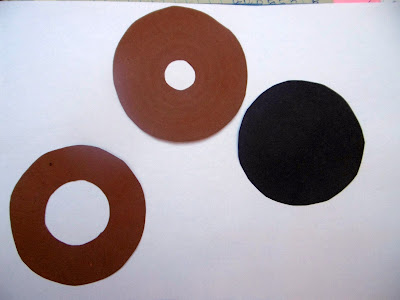Context
SCIENE/
Sense organs
Materials
Poster of
the eye with paper labels that can be attached with sello tape
Model of
the eye made of:
- A ball to make the round eye
form
- A white soup bowl that is
placed on top of the ball
- Chitenge cloth wrapped around ball
and bowl to make the eyelids
- Iris and pupil cut out of brown
and black carton
LESSON
1)
External
Parts
·
Your
eyes lay well protected in their sockets in the skull (the learners shall
touch/feel the sockets of their eyes)
·
The
eyes are held there by muscles which can also move the eyes (the learners shall
roll their eyes)
·
The
eyes are protected by the eye lids, the eye lashes and eyebrow. They protect
the eye from dust and particles.
2)
Internal
parts
- If we could take out our eyes
of our head, we could see that they are round balls
- The white of the eye is the sclera.
It is a tough/hard material that gives shape to the eyeball, but it is
only a coat, like the peel of an orange
- When we cut an eye into two
halfs we could see how it looks inside, like on this poster
- Inside the eye, after the
sclera peel, there is a lot of jelly (like the vaseline jelly that
the learners use to cream themselves after bathing!)
- The front of the eye is a clear
transparent layer called the cornea (=soup bole of the eye model),
made of living cells, behind it is water
3)
light
- by the way, do you know how it
works that we can see things?
- Images of our surrounding only
come to us by light rays
- Everything you see reflects the
sunlight into your eyes:
- The sun shines on me
- I reflect the sunlight
- The light rays hit your cornea
and the cornea bends them inwards your eye!
- But our eyes are very
sensitive. The amont of light entering into the eye must be controlled.
This is done by the iris.
4)
iris
and lens
- The iris is the coloured ring
of the eye: it can be green, brown, blue or grey
- In the middle of the iris there
is a black hole, that´s the pupil
- The iris ring has two type of
muscles: radial and circular muscles
- In dim light, the radial
muscles contract and open the hole/pupil up so that more light can get in
- In bright light the circular
muscles contract and close the hole so that less light is let trough
- When the light passes the pupil there is one more obstacle in its way: the lens. The lens changes the direction of the light rays so that they can be focussed on the retina
5)
the
retina
- the retina is a layer at the
back of the eye balls. It contains two type of cells that are sensitive
for light: rods and cones
- with the cone cells we can see
different colours. In our eye, we can find the cones directly behind the
pupil. The cone cells only work during daylight. In the night it is very
difficult to distinguish colours, because there is not enough light for
the cone cells.
- In the night we only see with
our rod cells. They need vitamin A to work properly. For good night vision
it helps to eat mangoes, pawpaws, carrots, green vegetables and butter.





Keine Kommentare:
Kommentar veröffentlichen